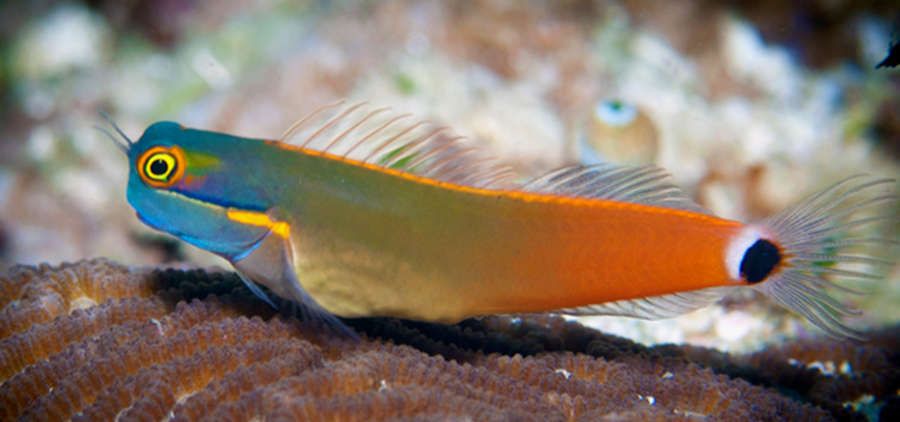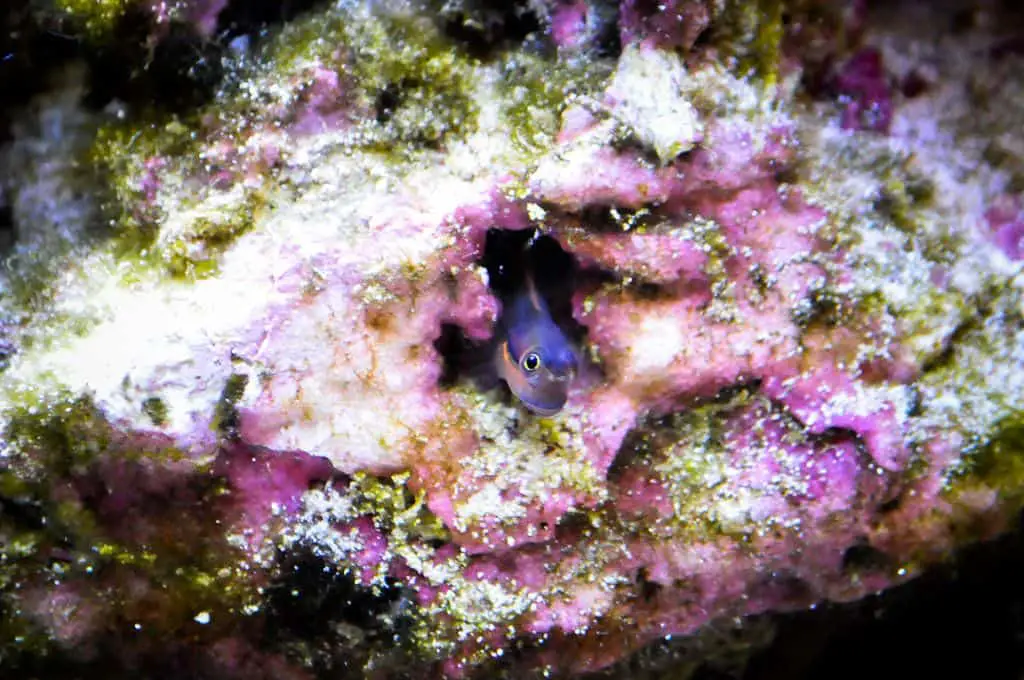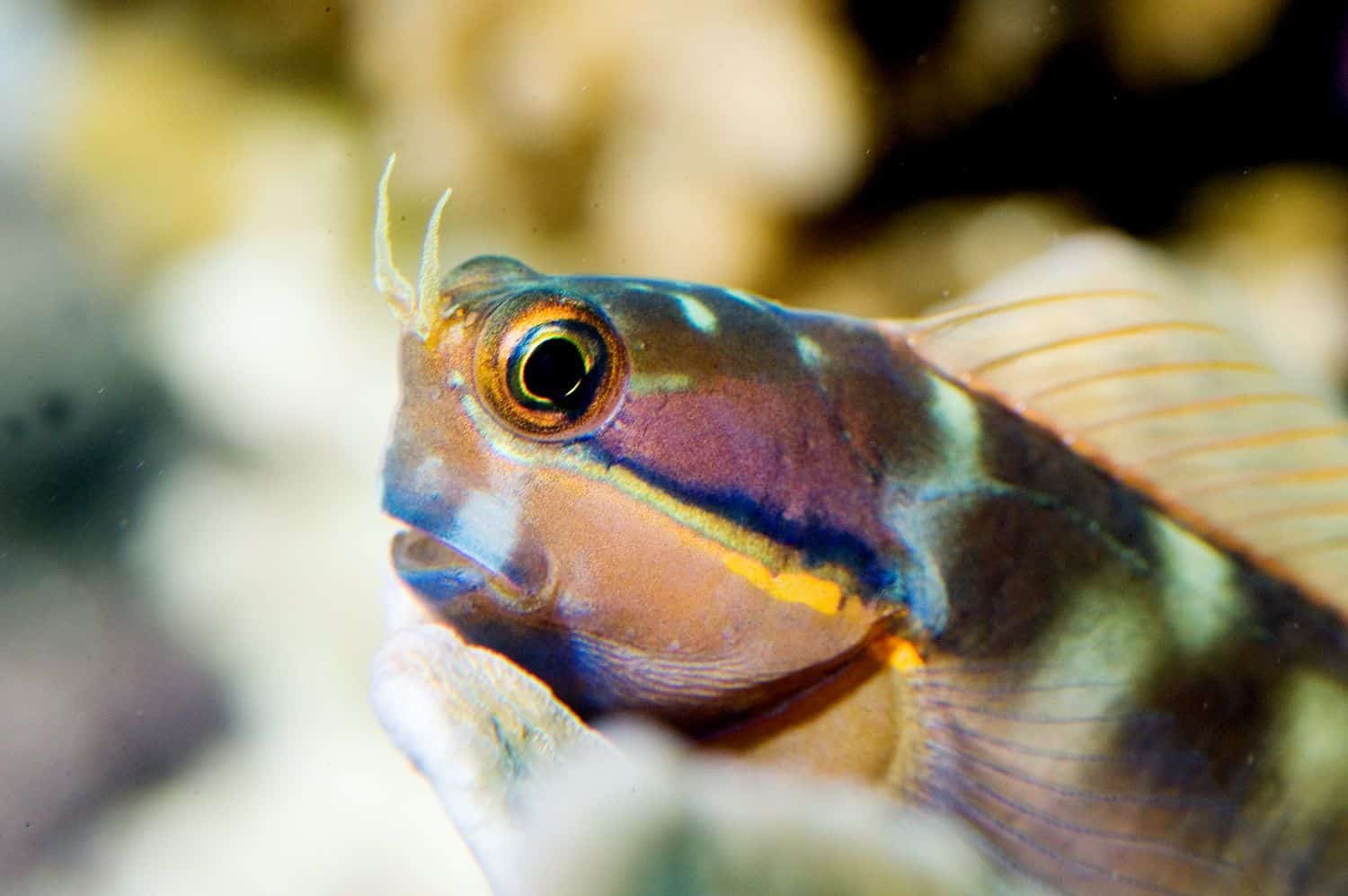The tailspot blenny (ecsenius stigmatura) is a popular inhabitant in many saltwater aquariums. They are found primarily in the Western Pacific oceans but has been incorporated into saltwater tanks around the world. Typically, the male blenny is brighter in color and has longer fins. Female blennies, which are in good health, will appear to have larger bellies.
The fishes’ color can range from gray to a coppery-brown/orange with a blue-gray head. The tailspot blenny is one of the smaller species of blennies and is an overall easy-to-care-for fish. It has a laid-back attitude and doesn’t require any special tank modifications.
| Scientific Name | Ecsenius stigmatura |
|---|---|
| Family | Blenniidae |
| Temperament | Peaceful |
| Care Level | Easy |
| Diet | Herbivore |
| Feeding Habits | Algae strips, Algae flakes, Frozen foods, freeze dried foods. |
| Size | 2.5" |
| Reef Safe | Yes |
| Tank Size | 10 Gallons Minimum |
| Origin | Cebu |
| Breeding | Difficult |
| Suitable tank mates | Shrimps,Clownfish, Dwarf Angelfish, Wrasse, Damsels, Filefish |
| Recommended first fish? | Yes |
| Jumper? | Yes, they often jump out so cover the aquarium |
| Lifespan | 3-5 Years |
| Cost | $25-$30 |
Table of Contents
How To Care For A Tailspot Blenny
When bringing a new fish into your aquarium, it’s important to know how best to care for it. The tailspot blenny doesn’t require a lot of special care but will benefit from a knowledgeable caretaker and some love and attention. Generally, the tailspot blenny will live 2-5 years in captivity. However, it can live longer under the right conditions and with the right care. You will need to provide some nice hiding places for them to retreat to when they feel threatened.
Be aware that it can take a week or so for them to build up confidence before exploring their new home. It’s not uncommon for them not to be seen for the first few days after adding them to your aquarium.
What Do Tailspot Blennies Eat?
The tailspot blenny is known to eat a large amount of algae. Introducing them into an aquarium that already has a sufficient algae buildup will make them happy. Offer your Blenny plenty of vegetable matter. This includes dried seaweed, algae flakes, and algae wafers that have been specifically formulated for marine fish.
In the right conditions, filamentous algae can be grown on rocks and then rotated. Switch with the rocks in the main aquarium to provide your blenny with a fresh source of algae to graze on. To anchor the algae to rocks and other objects, try using a rubber band to hold the culture in place.
We use TetraMarine Flakes as they offer a great base diet for your blenny. In addition, we also feed them supplementary foods and plenty of live foods and copepods.
Vitamin enriched brine shrimp and Mysis shrimp can be offered as a treat. However, such shrimps should not be given as the main staple – tailspot blennies need to have a vegetable-heavy diet. Omega One freeze-dried brine shrimp is a good product and we have used this for many years. You can purchase it from Chewy.com. Here’s a link.
Your blenny will need to be fed 2-3 small meals per day, depending on how much algae is in your tank. If your blenny is being underfed, he or she may begin to nip and pick at SPS corals and LPS corals, as well as clam mantles.
https://youtu.be/zhjzk92t-n8
What’s The Natural Habitat For A Tailspot Blenny?
The tailspot blenny is reef compatible and will do well with other non-aggressive fish. Tailspot blennies are bottom-dwelling fish. It is best not to house them with other bottom-dwellers or single blennies; unless you plan to keep the blennies in a male-female pair. Although not aggressive, they can be territorial with others of their kind or other species which have a similar appearance.
What is the best tank set up for the tailspot blenny?
If you want to house more than one blenny, do so in a large tank (50+ gallons) for the best chance of success. Be sure to monitor your blennies for signs of unrest. It’s also best to avoid housing your blenny with larger, more aggressive fish. This is because the blenny is easily intimidated and may stop eating if he or she is scared.
The aquarium itself should be at least 15 – 20 gallons, but of course, the bigger the better – especially if your blenny will have tank mates. The tank should have a tight-fitting lid, as this species is apt to jump out of their tank. The tank’s temperature should sit at 73-81 degrees Fahrenheit. The tank we have listed here is one of our favorites. It’s a 15 Gallon aquarium with filters and light built-in and perfect for smaller saltwater fish like Tailspot Blennies.
Cover the bottom of the tank ideally with a sand substrate. In addition to a scattering of live rock for hiding, grazing, and resting. Tailspot blennies are live in small crevices in the wild, so don’t be afraid to create tight-fitting spaces with your live rock.
Although the tailspot blenny doesn’t need certain lighting conditions or water filtration systems, it does prefer calm water. We recommend the use of a low-flow filtration system as these so not disturb the water too much.
Fitting a lid to the tank is best practice; these fish are expert jumpers and have been known to jump straight out of their tank and onto the floor. Many fishkeepers have found their beautiful blenny laying dead on the floor. Many saltwater aquariums don’t have lids. It is advisable in the first week to place a sheet of clear acrylic or plastic over the top until he is comfortable in his or her new surroundings.

Can You Breed Tailspot Blenny?
There have been a number of cases of tailspot blennies mating in captivity. When this happens, the male will usher the female towards a small, pre-selected cave of his choosing. The female deposits her demersal eggs on the walls and ceiling of the cave. Once she is done, the male goes inside the cave to quickly fertilize the eggs.
Over a period of 4 or 5 days, the female might deposit several batches of eggs, all of which the male must fertilize. Until they hatch, he will guard them. The eggs hatch within 24-72 hours and once they do, keeping them alive can be a challenge.
At this point, it is best to move the eggs into a separate breeding tank. You set this up specifically for rearing and with matching water parameters. On full absorption of the yolk sacs, the tiny fish will need a constant supply of food such as rotifers, to help them grow and keep them healthy.
Tailspot Blennies are, however, very difficult to breed and very few are done in captivity.

F.A.Q
Can a tailspot blenny solve my algae problem?
No. Tailspot blennies are small creatures and in a large tank, the amount of algae that they eat won’t make a difference if you have an abundance of it. In smaller tanks, however, they may make a slight difference, but should not be relied upon. In aquariums where there is a lack of algae, you will need to feed them a balanced diet which includes plenty of vegetable matter.
Can I keep different types of blennies together?
Blennies are known to harass fish that look similar to them, so it’s best not to house different types of blennies together, as they all tend to have a similar shape and size. This is especially true when tailspot blennies are involved because they are a very timid species and are easily spooked.
What fish are good tank mates for tailspot blennies?
Tailspot blennies are very peaceful with other species of fish and can make great community aquarium fish. A few fish we can suggest you can keep safely with them are: clownfish, Pink margin wrasse, Mimic Saddle Filefish and Longhorn cowfish.
What fish can I house my blenny with?
A relatively peaceful fish, you can successfully keep Blennies with most species of non-aggressive fish. This includes gobies, yellow tangs and basslet fish to name a few.
Tailspot blennies are wonderful fish for any saltwater aquarium. They are beautiful to look at and seem to have their own personalities. In addition, they are easy to care for and get along well with a variety of other fish. Feed Blennies a strict vegetable-heavy diet and have plenty of places for them to hide and perch, as well as ample space to graze.
What’s the difference between a Blenny & Goby?
Gobies generally have fused pectoral fins that form a cup that they use to prop themselves up on and to grasp vertical walls. Blennies generally have a continuous, long dorsal fin that runs the length of the body to the tail: They also have projections called cirri, on their head, that the gobies lack.
The Blenny fish are believed to be among the most intelligent of fishes, they are relatively fearless, constantly active, and their large, upturned mouths mimic what some would describe as a “cheerful” smile.
How much does a Tailspot blenny cost?
These amazing fish are available from most aquarium stores with a price tag in the region of $25 US Dollars.
Conclusion: Tailspot Blenny Care Guide
The tailspot blenny gets its name from a dark spot at the base of its tail. A black and yellow band runs below each eye, aiding them in blending into their surroundings.
We just love the character that comes out of these fish once they have settled into their new home. They soon become a pleasure to watch and dart around the tank having fun. They never stray too far from their home and dart back at the first sign of danger.
Please lets us know if you own one of these lovely saltwater fish or if you’re planning on buying one.
Happy Fishkeeping.
Another great saltwater fish to consider is the Firefish Goby.

I have been working in the tropical fish industry for over 30 years now and I’m still learning. Everyday is a school day in this hobby. In my spare time I play golf very badly!



